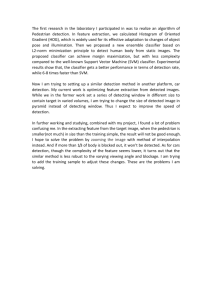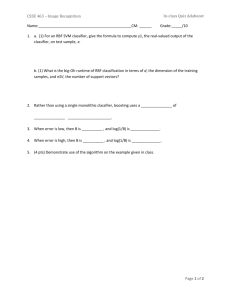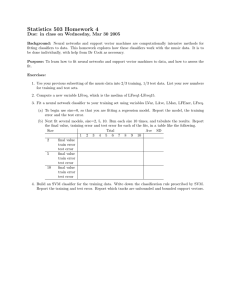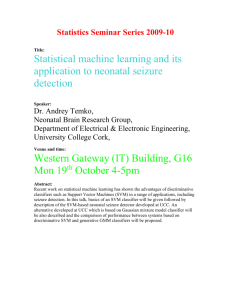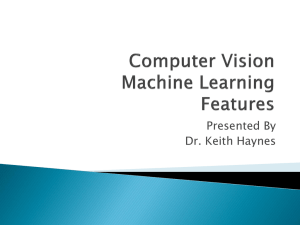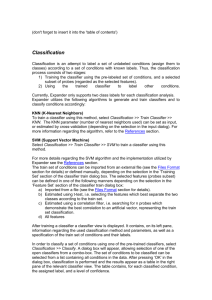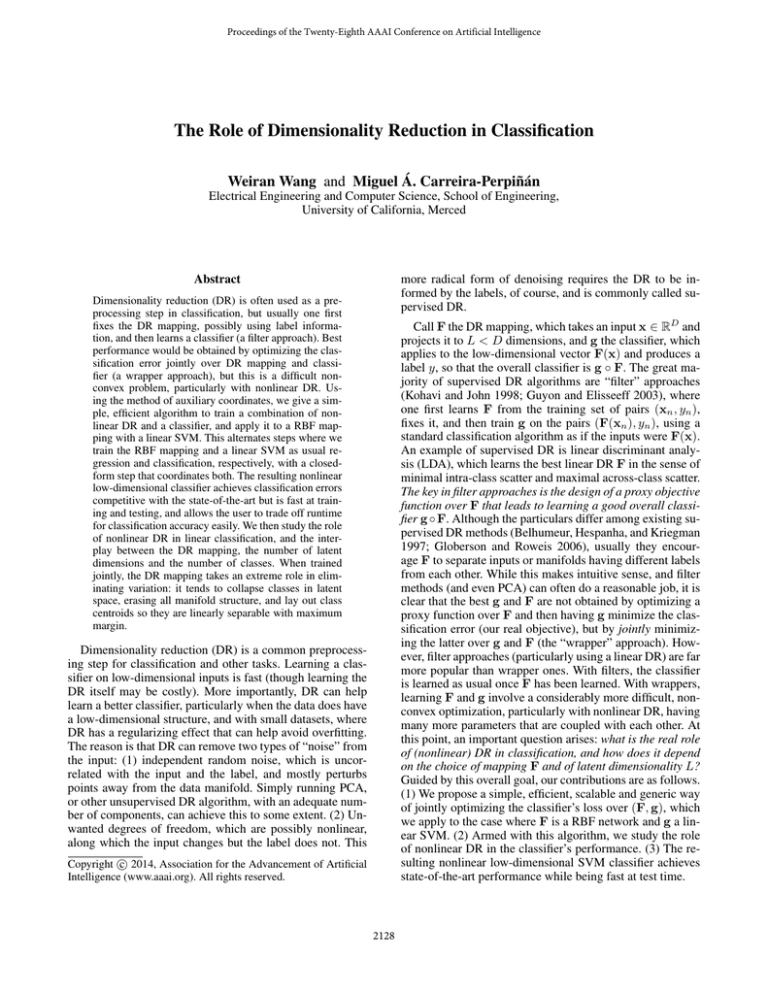
Proceedings of the Twenty-Eighth AAAI Conference on Artificial Intelligence
The Role of Dimensionality Reduction in Classification
Weiran Wang and Miguel Á. Carreira-Perpiñán
Electrical Engineering and Computer Science, School of Engineering,
University of California, Merced
Abstract
more radical form of denoising requires the DR to be informed by the labels, of course, and is commonly called supervised DR.
Dimensionality reduction (DR) is often used as a preprocessing step in classification, but usually one first
fixes the DR mapping, possibly using label information, and then learns a classifier (a filter approach). Best
performance would be obtained by optimizing the classification error jointly over DR mapping and classifier (a wrapper approach), but this is a difficult nonconvex problem, particularly with nonlinear DR. Using the method of auxiliary coordinates, we give a simple, efficient algorithm to train a combination of nonlinear DR and a classifier, and apply it to a RBF mapping with a linear SVM. This alternates steps where we
train the RBF mapping and a linear SVM as usual regression and classification, respectively, with a closedform step that coordinates both. The resulting nonlinear
low-dimensional classifier achieves classification errors
competitive with the state-of-the-art but is fast at training and testing, and allows the user to trade off runtime
for classification accuracy easily. We then study the role
of nonlinear DR in linear classification, and the interplay between the DR mapping, the number of latent
dimensions and the number of classes. When trained
jointly, the DR mapping takes an extreme role in eliminating variation: it tends to collapse classes in latent
space, erasing all manifold structure, and lay out class
centroids so they are linearly separable with maximum
margin.
Call F the DR mapping, which takes an input x ∈ RD and
projects it to L < D dimensions, and g the classifier, which
applies to the low-dimensional vector F(x) and produces a
label y, so that the overall classifier is g ◦ F. The great majority of supervised DR algorithms are “filter” approaches
(Kohavi and John 1998; Guyon and Elisseeff 2003), where
one first learns F from the training set of pairs (xn , yn ),
fixes it, and then train g on the pairs (F(xn ), yn ), using a
standard classification algorithm as if the inputs were F(x).
An example of supervised DR is linear discriminant analysis (LDA), which learns the best linear DR F in the sense of
minimal intra-class scatter and maximal across-class scatter.
The key in filter approaches is the design of a proxy objective
function over F that leads to learning a good overall classifier g ◦ F. Although the particulars differ among existing supervised DR methods (Belhumeur, Hespanha, and Kriegman
1997; Globerson and Roweis 2006), usually they encourage F to separate inputs or manifolds having different labels
from each other. While this makes intuitive sense, and filter
methods (and even PCA) can often do a reasonable job, it is
clear that the best g and F are not obtained by optimizing a
proxy function over F and then having g minimize the classification error (our real objective), but by jointly minimizing the latter over g and F (the “wrapper” approach). However, filter approaches (particularly using a linear DR) are far
more popular than wrapper ones. With filters, the classifier
is learned as usual once F has been learned. With wrappers,
learning F and g involve a considerably more difficult, nonconvex optimization, particularly with nonlinear DR, having
many more parameters that are coupled with each other. At
this point, an important question arises: what is the real role
of (nonlinear) DR in classification, and how does it depend
on the choice of mapping F and of latent dimensionality L?
Guided by this overall goal, our contributions are as follows.
(1) We propose a simple, efficient, scalable and generic way
of jointly optimizing the classifier’s loss over (F, g), which
we apply to the case where F is a RBF network and g a linear SVM. (2) Armed with this algorithm, we study the role
of nonlinear DR in the classifier’s performance. (3) The resulting nonlinear low-dimensional SVM classifier achieves
state-of-the-art performance while being fast at test time.
Dimensionality reduction (DR) is a common preprocessing step for classification and other tasks. Learning a classifier on low-dimensional inputs is fast (though learning the
DR itself may be costly). More importantly, DR can help
learn a better classifier, particularly when the data does have
a low-dimensional structure, and with small datasets, where
DR has a regularizing effect that can help avoid overfitting.
The reason is that DR can remove two types of “noise” from
the input: (1) independent random noise, which is uncorrelated with the input and the label, and mostly perturbs
points away from the data manifold. Simply running PCA,
or other unsupervised DR algorithm, with an adequate number of components, can achieve this to some extent. (2) Unwanted degrees of freedom, which are possibly nonlinear,
along which the input changes but the label does not. This
c 2014, Association for the Advancement of Artificial
Copyright Intelligence (www.aaai.org). All rights reserved.
2128
Joint optimization of mapping and classifier
using auxiliary coordinates
g-step For fixed (F, Z), optimizing over w, b, ξ is just
training an ordinary linear SVM with low-dimensional inputs Z. Extensive work exists on fast, scalable SVM training. We use LIBSVM (Chang and Lin 2011). With K
classes, each SVM is trained independently of the others.
Given a training set of N input patterns xn ∈ RD and corresponding labels yn ∈ {−1, +1}, n = 1, . . . , N , we want to
learn a nonlinear low-dimensional classifier g ◦ F that optimizes the following objective:
F-step For fixed (g, Z), optimizing over F is just a regularized regression with inputs X and low-dimensional outputs Z. So far the approach is generic over F, which could
be a deep net or a Gaussian process, for example. However, we now focus on a special case which results in a
particularly efficient step over F, and which includes linear DR as a particular case. We use radial basis function
(RBF) networks, which are universal function approximators, F(x) = WΦ(x), with M N Gaussian RBFs
φm (x) = exp(− 21 k(x − cm )/σk2 ), and R(F) = kWk2 is
a quadratic regularizer on the weights. As commonly done
in practice (Bishop 2006), we determine the centers cm by
k-means on X, and then the weights W have a unique solution given by a linear system. The total cost is O(M (L+D))
in memory and O(N M (M + D)) in training time, mainly
driven by setting up the linear system for W (involving
the Gram matrix φm (xn )); solving it exactly is a negligible
O(M 3 ) since M N in practice, which can be reduced to
O(M 2 ) by using warm-starts or caching its Cholesky factor.
Note we only need to run k-means and factorize the linear
system once and for all, since its input X does not change.
Thus, the F-step simply involves a linear system for W.
N
X
1
2
min λR(F) + kwk + C
ξn
(1)
F,g,ξ
2
n=1
N
s.t. yn (wT F(xn ) + b) ≥ 1 − ξn , ξn ≥ 0 n=1 .
This is the usual linear SVM objective of finding a separating hyperplane with maximum margin, but with inputs
given by F, which has a regularization term λR(F), where
g = {w, b} are the weights and bias of the linear SVM
g, and with a slack variable ξn per point n, where C is a
penalty parameter for the slackness. The difficulty is that the
constraints are heavily nonconvex because of the nonlinear
mapping F. However, the problem can be significantly simplified if we use the recently introduced method of auxiliary coordinates (MAC) (Carreira-Perpiñán and Wang 2012;
2014) for nested systems. The idea is to introduce auxiliary
variables that break nested functional dependence g(F(·))
into simpler shallow mappings g(z) and F(·). In our case,
we introduce one auxiliary vector per input pattern and define the following constrained problem, which can be proven
(Carreira-Perpiñán and Wang 2014) to be equivalent to (1):
min λR(F) +
F,g,ξ,Z
N
X
1
2
kwk + C
ξn
2
n=1
(2)
Z-step For fixed (F, g), eq. (3) decouples on each n, so
instead of one problem on N L parameters, we have N independent problems each on L parameters, of the form (omitting subindex n):
N
s.t. yn (wT zn + b) ≥ 1 − ξn , ξn ≥ 0, zn = F(xn ) n=1 .
This seems like a notational trick, but now we solve this with
a quadratic-penalty method (Nocedal and Wright 2006). We
optimize the following problem for fixed penalty parameter
µ > 0 and drive µ → ∞:
N
N
X
1
µ X
2
2
kwk + C
ξn +
kzn − F(xn )k
2
2 n=1
n=1
(
)N
yn (wT zn + b) ≥ 1 − ξn
.
ξn ≥ 0
2
min kz − F(x)k + 2C/µξ
(4)
z,ξ
s.t. y(wT z + b) ≥ 1 − ξ,
ξ≥0
min λR(F) +
F,g,ξ,Z
s.t.
where we have also included the slack variable, since we find
this speeds up the alternating optimization. This is a convex
quadratic program with closed-form solution z = F(x) +
γyw, where γ is a scalar which takes one of three possible
values (Wang and Carreira-Perpiñán 2014), and costs O(L).
(3)
n=1
This defines a continuous path (F∗ (µ), g∗ (µ), Z∗ (µ))
which, under mild assumptions, converges to a minimum
of the constrained problem (2), and thus to a minimum of
the original problem (1). Although problem (3) has more
parameters, all the terms are simple and partially separable.
The auxiliary vector zn can be interpreted as a target in latent space for the mapping F, but these targets are themselves coordinated with the classifier. Using alternating optimization of (3) over (F, g, Z) results in very simple, convex
steps. The (F, g) step is a usual RBF regression and linear SVM classification done independently from each other
reusing existing, well-developed algorithms. The Z-step has
a closed-form solution for each zn separately.
With K classes, we use one-vs-all scheme (Rifkin and
Klautau 2004) and train K binary SVMs, one per class. The
final label is given by the SVM with largest decision value.
The objective in (1) is replaced by the sum of the K SVMs’
objective functions (Wang and Carreira-Perpiñán 2014).
Summary and practicalities Jointly optimizing the classification error over g and F becomes iterating simple convex subproblems: RBF regression, linear SVM and a closedform update for Z. Remarkably, we do not require any involved gradient computation, but reuse existing techniques
for training F and g efficiently. Thus, although the problem (1) is nonconvex and has multiple local optima, the algorithm is deterministic given its initialization. We run the algorithm from an initial Z. We observe that, given reasonable
hyperparameters, even random values work well. In the first
1–2 iterations, the zn quickly reorganize in latent space, and
they only get refined afterwards so as to enlarge the margin
and reduce the bias. We use a initial value of µ = 2 for the
quadratic penalty parameter and increase it times 1.5 when
the alternating scheme converges for fixed µ. We use early
2129
Methods
NN
Linear SVM
PCA (L = 2)
LDA (L = 1)
Ours (L = 1)
Ours (L = 2)
Ours (L = 20)
stopping, by exiting the iteration when the error in a validation set does not change or goes up. This helps to improve
generalization and is faster: we observe a few iterations suffice, because each step updates very large, decoupled blocks
of variables, and we need not drive µ → ∞ or achieve convergence. The hyperparameters are the usual ones: M , σ, λ
for the RBF mapping F, and C for the SVM g, and can be
determined by cross-validation.
The form of P
our final classifier is y = g(F(x)) =
M
vT Φ(x) + b = m=1 vm φm (x) + b where v = WT w ∈
M
R , and the sign of y gives the label. The number of parameters (weights and centers) is M (D + L) + L = O(M D)
and the runtime for a test point O(M D).
PCA
Error (%)
19.16 (0.74)
13.5 (0.72)
42.10 (1.22)
14.21 (1.63)
13.12 (0.67)
12.94 (0.82)
12.76 (0.81)
Ours
PC
MAC
Experiments
We explore three questions across a range of datasets: the
role of dimension reduction; the performance of our classifier, compared to the state-of-the-art; and the training speed
of our algorithm. We compare with directly applying a nearest neighbor classifier (NN) and linear (LSVM) or Gaussian
kernel SVMs (GSVM) on the original inputs, with unsupervised DR methods PCA/Gaussian Kernel PCA (KPCA) followed by nearest neighbor, and with filter approaches such
as LDA/KLDA (Gaussian kernel) followed by nearest neighbor. Hyperparameters for these algorithms (kernel width σ
for kernel SVM, KPCA, and KLDA, penalty parameter C
for SVMs) are chosen by grid search on a separate validation set. We initialize our algorithm randomly.
Figure 3: Results on the PC/MAC subset of 20 newsgroups.
Top: mean mean test error rate (with Std in parenthesis) over
10 splits. Bottom: projections by different algorithms.
ples from different classes are pushed far apart (especially
if using M = all 2000 training samples as RBFs centers),
so as to be easily separated by g with big margin, and our
classifier g ◦ F is capable of solving linearly non-separable
problems given sufficient BFs; (3) to achieve a perfect classification, only a few basis functions are needed (M = 100
is more than sufficient here); (4) F(x) approximately form a
line, implying that L = 1 is enough to separate two classes.
We then study the role of the latent dimension L, the number of classes K and the geometric configuration of the latent projections. We vary K in the spirals dataset from 2 to
6, with 500 samples in each spiral, and run our algorithm
with F being nonparametric RBFs and L = 1, . . . , 10, fixing other hyperparameters at reasonable values. Fig. 2 shows
the classification results and projections F(X). We find we
can not always obtain perfect classification using only L = 2
dimensions for the one-vs-all SVMs. Instead, we find a common behavior for different K: the classification performance
improves drastically as L increases in the beginning, and
then stabilizes after some critical L, by which time the training samples are perfectly separated. This is because once the
classes are separable in RL , they can also be (more easily)
separable in higher dimensions with more degrees of freedom to arrange them. We observe also that typically with
L = K −1 dimensions, the classes all form a point-like cluster and approximately lie on vertices of a regular simplex,
with zero classification error (decision boundaries shown in
the first column). This gives a recipe to choose L: increase L
until classification error does not improve, and K − 1 seems
to be a good starting point.
The ideal nonlinear dimensionality reduction + linear
classifier Given that the classifier g is linear, consider the
ideal case where F is infinitely flexible and can represent any
desirable mapping from D to L dimensions. Then a perfect
classifier g ◦ F can be achieved by having F map all inputs
having the same label k to a point µk ∈ RL , and then locating the K class centroids µ1 , . . . , µK in RL such that they
are linearly separable and have maximum margin. How this
can be achieved depends on the dimension L. With L = 1,
only K = 2 classes may be linearly separable. With L = 2,
all K classes are linearly separable if placing the centroids
on the vertices of a regular K-polygon; however, this leads
to a small margin as K grows. In L > 2, this generalizes
to placing the centroids maximally apart on a hypersphere.
However, when L ≥ K − 1, the K points span a space of
K −1 dimensions, specifically a regular simplex, which provides linear separability and maximum margin. Is this ideal
actually realized?
We investigate this question experimentally. The dataset
in fig. 1 contains two spirals, each has 1 000 samples and
defines a class. We change the flexibility of F to see what
latent representations are obtained. We try a linear DR and a
RBF DR with varying number of basis functions (M centers
uniformly sampled from the training set) while keeping the
other hyperparameters fixed. We observe the following from
the projections F(X) shown in fig. 1: (1) since the dataset
is not linearly separable, the two classes overlap severely
in the latent space for linear F (first column); (2) the more
flexible F is, the more classes collapse and training sam-
In summary, these results are in approximate agreement
with our ideal prediction, although the extent to which F
collapses classes depends on the number of basis functions
M in practice. The larger M is, the more flexible F is and
the closer the latent projections are to K centroids in a
maximally linearly separable arrangement, and this behavior arises from the joint optimization of DR and classifier.
2130
F linear
M =4
M = 10
M = 20
M = 40
M = 100
M = 200
M = 2000
Figure 1: Experimental results on the two spirals dataset. We vary the flexibility of F to investigate the ideal dimensionality
reduction for g. Top: dataset and decision boundary (black curves) achieved with different F. Bottom: 2D projections F(X)
and the SVM g boundary (black line).
L=1
L=2
L=3
L=4
L=5
L=6
L=7
L=8
L=9
L = 10
K=6
K=4
K=2
data
Figure 2: Experimental results on the K-spirals dataset. Each row shows results for a different K. First column: datasets and
decision boundaries (black curve) obtained at L = K − 1. We apply PCA to visualize the latent representations in 2D.
Method
Error # BFs
Nearest Neighbor
5.34 10 000
9.20
–
Linear SVM
Gaussian SVM
2.93 13 827
LDA (9) + Gaussian SVM 10.67 8 740
PCA (5) + Gaussian SVM 24.31 13 638
5 894
PCA (10) + Gaussian SVM 7.44
PCA (40) + Gaussian SVM 2.58 12 549
4.69
2 500
Ours (5 , 43)
Ours (10, 18)
2.99
2 500
PCA (40) + Ours (10, 17)
2.60
2 500
Figure 4: Test error rates (%) and number of basis functions
used in each method on MNIST 10-classes problem. We
specify L for LDA/PCA, L and number of iterations used
to reach early stopping for our algorithm in parenthesis.
Document binary classification We perform binary classification on the two topics comp.sys.ibm.pc.hardware and
comp.sys.mac.hardware from the 20 newsgroup dataset using the TFIDF features. For evaluation, we create 10 different 80/20 splits of the 1 162 training items into training and validation set. For each split, we let all algorithms
pick the optimal hyperparameters based on validation error,
and evaluate the optimal models on the test set. Due to the
high dimensionality and scarcity of samples, we use linear F
for this problem (using RBFs achieves similar results). The
mean and standard deviation of test error rates over 10 splits
for all methods are shown in fig. 3 (top).
Our classification performance is quite robust to the
choice of L, although in general larger L may bring a little
improvement in the error rate at higher computational cost.
We fix the latent dimensions to be 2 for other methods. The
results show that using class information in dimensionality
reduction is superior to not using it (e.g. PCA), and we outperform others consistently with different L. Fig. 3 (bottom)
shows the 2D projections, where our algorithm manages to
separate the classes and PCA can not.
eigenvalue problem. Our algorithm uses 2 500 BFs with centers chosen by K-means. Hyperparameters are searched in a
way that avoids unnecessary regions of the space (Wang and
Carreira-Perpiñán 2014).
Fig. 4 shows the test error rates and the total number of
support vectors (from the 10 Gaussian SVMs)/basis functions used in each algorithm. Our accuracy is similar to that
of the kernel SVM but with 5.5 times fewer basis functions,
obtaining a large speedup in testing time. We have explored
the approach of PCA/LDA+Gaussian SVM and obtained
a similar result: LDA (L = 9)+Gaussian SVM performs
poorly; PCA+Gaussian SVM performs well at a relatively
larger L. We train our model on the PCA projection, further
MNIST 10-classes We now consider the problem of classifying the 10 digit classes of MNIST. We randomly sample
10 000 images for training and 10 000 for validation. The
original test set is used for evaluating different algorithms.
We are not able to run KPCA and KLDA because the naive
implementation of these algorithms requires a huge memory
space to store the kernel matrix of N × N and solve a dense
2131
70
8
50
speedup
error rate (%)
60
40
30
6
4
20
2
10
0
5
10
15
20
25
2
30
4
6
8
10
12
# processors
L
Figure 5: Results of MNIST 10-classes experiment. Left: error rate of our algorithm over a range of latent dimensions. Middle:
2D embedding of our algorithm, we apply PCA to the latent representations obtained at L = 10 (to avoid cluttering, we plot a
subset of 500 images). Right: speedups obtained by running our algorithm using the Matlab Parallel Processing Toolbox.
g(F(x)) = vT Φ(x)+b, with M BFs in our case and S support vectors for the SVM. The SVMs do this nonparametrically, at the cost of constructing an N × N kernel matrix and
solving the corresponding problem, which is expensive (although much research work has sought approximating this
(Schölkopf and Smola 2001) and reducing the number of
SVs (Bi et al. 2003)). The basis functions Φ(x) are given
by the kernel, which is selected by the user, and the space
they implicitly map to is typically infinite-dimensional. The
number of SVs S is not set by the user but comes out automatically and can be quite large in practice. Our method is
a parametric approach, where the user can set the number of
BFs M , and the mapping F (in this paper, an RBF mapping)
maps to a low-dimensional space. The result is a competitive nonlinear classifier, with scalable training and efficient
at test time. Having M as a user parameter also allows a
simple, direct way for the user to trade off test runtime for
accuracy, which is crucial in real-time problems, such as embedded systems, where a typical SVM classifier is too computationally demanding in both memory required to store
the SVs and in runtime. As shown in the experiments, we
can obtain a classification error comparable to kernel SVM
with M S, thus much faster.
It is possible to train a linear SVM by learning v and b
directly given fixed basis functions φ(x), but this achieves
a worse classification error, and does not do DR. Our lowdimensional classifier can be seen as a special regularization
structure on the classifier’s weights v = WT w, where W
and w are regularized separately. This effect is more pronounced in the multiclass case since each one-vs-all SVM
wk interacts with the same dimensionality reduction mapping W. If using a different functional form for F (e.g. deep
nets), this resemblance with kernel SVMs disappears.
Our algorithm affords massive parallelization and is suitable for large scale learning. The F-step (a regression problem) decouples over latent dimensions, the g-step (oneversus-all SVM) decouples over classes, and the Z-step
decouples over training samples. Indeed, our experiments
show linear speedups with multiple processors.
Being able to find true optima of the classification error
allowed us to study the role of nonlinear DR as a preprocessing step for classification. With an ideally flexible DR
reduce the dimension to L = 10, and obtain similar performance with much fewer basis.
Fig. 5(left) shows the performance of our algorithm using
different values of the latent dimension L. Our error rates decrease quickly as L increases at first. After L = 5, it already
does pretty well, and the performance does not change much
for L ≥ 10. We conjectured previously that the optimal latent configuration would be to arrange different classes on
the vertices of a regular simplex. This is supported in this
experiment by the projections achieved by our algorithm in
fig. 5(middle). PCA is used to visualize the latent representations at L = 10, though more powerful algorithms like
t-SNE (van der Maaten and Hinton 2008) completely separate all classes in a 2D embedding.
Training runtime and parallel processing We compare
our three-step alternating optimization scheme with a twostep alternating optimization scheme over only F and g
which optimizes (1) directly. We are much faster in terms
of both progress in objective function and actual runtime
(Wang and Carreira-Perpiñán 2014). We also ran a simple
parallel version of our algorithm in the MNIST 10-classes
problem, which solves the 10 SVMs in the g-step and the
decoupled Z-step for all points in parallel. Using up to 12
processors with the Matlab Parallel Processing Toolbox, we
obtain a near-linear speedup of up to 8 times (fig. 5 right).
Discussion
Our algorithm illuminates the behavior of filter approaches.
Such approaches optimize a proxy objective function constructed from (xn , yn ) over F and then learn the classifier
g by optimizing the classification error constructed from
(F(xn ), yn ) over g. This is like our F- and g-steps, but (1)
it uses the “wrong” objective for F, and (2) without the coordination through the Z variables, the process cannot be
iterated to converge to a minimum of the joint problem. We
can then view our algorithm as a corrected, iterated filter approach. Since in practice it converges in a few iterations, its
cost is just a little larger, but one needs not introduce a proxy
objective and yet obtains a true minimum.
Our method and kernel SVMs can be seen as constructing a classifier as an expansion in basis functions y =
2132
mapping F, the best possible preprocessing is precisely to
remove all variation that is unrelated to the class label, including variation within a manifold—an extreme form of
denoising. The input domains are “denoised” so they collapse to nearly zero-dimensional regions. Note that collapsing classes requires a genuinely nonlinear DR. The problem
formulation (1) does not explicitly seek to collapse classes,
but this behavior emerges anyway from the assumption of
low-dimensional representation, if trained jointly with the
classifier. Rather than making the classifier work hard to approximate a possibly complex decision boundary, we help it
by moving the data around in latent space so the boundary is
simpler. This clashes with the widely held view that a good
supervised DR method should produce representations (often visualized in 2D) where the manifold structure of each
class is displayed. In fact, with an optimal DR the entire
manifold will collapse. This is different from unsupervised
DR, where we do want to extract informative features that
tell us something about the data variability; and from supervised regression, where only some of the input dimensions
should be collapsed (those which do not alter the output).
al. (2008)). This is closely related to supervised dictionary
learning (Yang et al. 2012), only that the bias (approximation error) always exists in the model. Also, in this model
the latent projections are an implicit function of the inputs,
i.e., to project a new input, one needs to solve a optimization problem using learned basis. In contrast, our F is an explicit mapping, directly applicable to test samples. In Ji and
Ye (2009), one directly minimizes the hinge loss of a SVM
that operates on linearly transformed inputs (therefore it is
a nested error, similar to us). The authors apply alternating
optimization over both mappings. Due to the linearity of F
and g, they are able to solve for g in the dual and solve for F
using SVD. This would not be possible in general if F has a
different nonlinear form. Also, the SVD solution of F limits
the maximum meaningful latent dimension L to the number
of classes. On the contrary, our algorithm is bias free, works
with any L, and trains a nonlinear DR mapping fast.
Auxiliary variables were used previously for unsupervised dimensionality reduction (Carreira-Perpiñán and Lu
2010) and regression (Wang and Carreira-Perpiñán 2012).
But the objective defined there, while jointly optimized over
a dimension reduction mapping F and a regressor g, differs
from a true wrapper objective function, and results in optima
for the combined mapping g ◦ F that are biased.
Related work
Filter approaches typically learn a DR mapping F using
the inputs and label information first, and then fit a classifier g to the latent projections and labels (F(xn ), yn ). Linear discriminant analysis (LDA) (Belhumeur, Hespanha, and
Kriegman 1997) and its kernel version KLDA (Mika et al.
1999) look for a transformation of the inputs such that, in
the latent space, the within-class scatter is minimized while
the between-class scatter is maximized. The solution for F
can be obtained by solving an eigenvalue problem. These
two algorithms can only produce up to L = K − 1 latent
dimensions for a K-class problem, due to the singularity of
the between-class scatter matrix. LDA has also been modified to work for manifold data (Sugiyama 2007), where the
projection mapping is still linear. The clear disadvantage of
filter approaches is the heuristic nature of the objective for
DR, which acts as a proxy for classification, and is therefore
not optimal for the classifier learned afterwards.
Metric learning algorithms (Xing et al. 2003; Goldberger
et al. 2005; Globerson and Roweis 2006; Weinberger and
Saul 2009; Davis et al. 2007) are closely related to DR for
classification, whose goal is to find a Mahalanobis metric (or
equivalently a linear transform) in input space such that samples in the same class are projected nearby in latent space
while samples from different classes are pushed far apart.
One achieves DR if the metric is low-rank. However, most
metric learning algorithms first solve a positive semidefinite
program without rank constraints, and then do a low-rank
approximation of the learned metric to enforce DR, thus optimality of the projection is no longer guaranteed.
There also exist several wrapper approaches that train the
DR mapping F jointly with a classifier g in a unified objective function. Pereira and Gordon (2006) propose an objective function that combines the approximation error of the
inputs using SVD and the hinge loss from applying a linear
SVM to the coordinates, so that the extracted representation
is good for classification (see also generalization in Rish et
Conclusion
We have proposed an efficient algorithm to train a nonlinear low-dimensional classifier jointly over the nonlinear DR
mapping and the classifier (a wrapper approach). The algorithm is easy to implement, reuses existing regression and
SVM procedures, and parallelizes well. The resulting classifier achieves state-of-the-art classification error with a small
number of basis functions, which can be tuned by the user.
The algorithm can be seen as an iterated filter approach with
provable convergence to a joint minimum. This justifies filter approaches that use a secondary criterion over the DR
mapping such as class separability or intra-class scatter in an
effort to construct a good classifier, but also obviates them,
since one can get the best low-dimensional classifier (under
the model assumptions) with just a little more computation.
Our experiments illuminate the role of DR in classification. If we optimize the classification error—the figure of
merit one really cares about—jointly over the DR mapping
and the classifier, the best DR in fact erases all structure
(manifold and otherwise) in the input other than class membership, and uses the latent space to place collapsed classes
so that they are maximally linearly separable. Future work
should analyze the role of DR with nonlinear classifiers.
Our algorithm generalizes beyond the specific forms of
DR mapping and classifier used here, and we are exploring
other combinations. In particular, one can replace the dimension reduction mapping with a complex feature-extraction
mapping that can handle invariances, such as convolutional
neural nets, and jointly optimize this and the classifier.
References
Belhumeur, P. N.; Hespanha, J. P.; and Kriegman, D. J. 1997.
Eigenfaces vs. Fisherfaces: Recognition using class specific
2133
linear projection. IEEE Trans. Pattern Analysis and Machine
Intelligence 19(7):711–720.
Bi, J.; Bennett, K.; Embrechts, M.; Breneman, C.; and Song,
M. 2003. Dimensionality reduction via sparse support vector machines. J. Machine Learning Research 3:1229–1243.
Bishop, C. M. 2006. Pattern Recognition and Machine
Learning. Springer Series in Information Science and Statistics. Berlin: Springer-Verlag.
Proc. of the 23rd Int. Conf. Machine Learning (ICML’06),
689–696.
Rifkin, R., and Klautau, A. 2004. In defense of one-vs-all
classification. J. Machine Learning Research 5:101–141.
Rish, I.; Grabarnilk, G.; Cecchi, G.; Pereira, F.; and Gordon, G. 2008. Closed-form supervised dimensionality reduction with generalized linear models. In McCallum, A.,
and Roweis, S., eds., Proc. of the 25th Int. Conf. Machine
Learning (ICML’08), 832–839.
Schölkopf, B., and Smola, A. J. 2001. Learning with Kernels. Support Vector Machines, Regularization, Optimization, and Beyond. Adaptive Computation and Machine
Learning Series. Cambridge, MA: MIT Press.
Sugiyama, M. 2007. Dimensionality reduction of multimodal labeled data by local Fisher discriminant analysis. J.
Machine Learning Research 8:1027–1061.
van der Maaten, L. J. P., and Hinton, G. E. 2008. Visualizing
data using t-SNE. J. Machine Learning Research 9:2579–
2605.
Wang, W., and Carreira-Perpiñán, M. Á. 2012. Nonlinear
low-dimensional regression using auxiliary coordinates. In
Lawrence, N., and Girolami, M., eds., Proc. of the 15th Int.
Workshop on Artificial Intelligence and Statistics (AISTATS
2012), 1295–1304.
Wang, W., and Carreira-Perpiñán, M. Á. 2014. The role
of dimensionality reduction in classification. Unpublished
manuscript, arXiv.
Weinberger, K. Q., and Saul, L. K. 2009. Distance metric
learning for large margin nearest neighbor classification. J.
Machine Learning Research 10:207–244.
Xing, E.; Ng, A.; Jordan, M.; and Russell, S. 2003. Distance metric learning with application to clustering with
side-information. In Becker, S.; Thrun, S.; and Obermayer,
K., eds., Advances in Neural Information Processing Systems (NIPS), volume 15, 521–528. MIT Press, Cambridge,
MA.
Yang, J.; Wang, Z.; Lin, Z.; Shu, X.; ; and Huang, T. 2012.
Bilevel sparse coding for coupled feature spaces. In Proc.
of the 2012 IEEE Computer Society Conf. Computer Vision
and Pattern Recognition (CVPR’12), 2360–2367.
Carreira-Perpiñán, M. Á., and Lu, Z. 2010. Parametric dimensionality reduction by unsupervised regression. In Proc.
of the 2010 IEEE Computer Society Conf. Computer Vision
and Pattern Recognition (CVPR’10), 1895–1902.
Carreira-Perpiñán, M. Á., and Wang, W. 2012. Distributed optimization of deeply nested systems. Unpublished
manuscript, arXiv:1212.5921.
Carreira-Perpiñán, M. Á., and Wang, W. 2014. Distributed
optimization of deeply nested systems. In Kaski, S., and
Corander, J., eds., Proc. of the 17th Int. Workshop on Artificial Intelligence and Statistics (AISTATS 2014), 10–19.
Chang, C.-C., and Lin, C.-J. 2011. LIBSVM: A library for
support vector machines. ACM Trans. Intelligent Systems
and Technology 2(3):27.
Davis, J. V.; Kulis, B.; Jain, P.; Sra, S.; and Dhillon, I. S.
2007. Information-theoretic metric learning. In Ghahramani, Z., ed., Proc. of the 24th Int. Conf. Machine Learning
(ICML’07).
Globerson, A., and Roweis, S. 2006. Metric learning by
collapsing classes. In Weiss, Y.; Schölkopf, B.; and Platt, J.,
eds., Advances in Neural Information Processing Systems
(NIPS), volume 18. MIT Press, Cambridge, MA.
Goldberger, J.; Roweis, S.; Hinton, G.; and Salakhutdinov,
R. 2005. Neighbourhood components analysis. In Saul,
L. K.; Weiss, Y.; and Bottou, L., eds., Advances in Neural
Information Processing Systems (NIPS), volume 17, 513–
520. MIT Press, Cambridge, MA.
Guyon, I., and Elisseeff, A. 2003. An introduction to variable and feature selection. J. Machine Learning Research
3:1157–1182.
Ji, S., and Ye, J. 2009. Linear dimensionality reduction for
multi-label classification. In Proc. of the 21st Int. Joint Conf.
Artificial Intelligence (IJCAI’09), 1077–1082.
Kohavi, R., and John, G. H. 1998. The wrapper approach. In
Liu, H., and Motoda, H., eds., Feature Extraction, Construction and Selection. A Data Mining Perspective. SpringerVerlag.
Mika, S.; Rätsch, G.; Weston, J.; Schölkopf, B.; and Müller,
K.-R. 1999. Fisher discriminant analysis with kernels. In
Hu, Y. H., and Larsen, J., eds., Proc. of the 1999 IEEE Signal
Processing Society Workshop on Neural Networks for Signal
Processing (NNSP’99), 41–48.
Nocedal, J., and Wright, S. J. 2006. Numerical Optimization. Springer Series in Operations Research and Financial
Engineering. New York: Springer-Verlag, second edition.
Pereira, F., and Gordon, G. 2006. The support vector decomposition machine. In Cohen, W. W., and Moore, A., eds.,
2134

